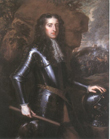|
YOU ARE HERE >> Irish Story > War > Battles > William of Orange
William of Orange
William of Orange was a Dutch prince, married to Mary, daughter of the English Duke of York. In 1685, William's father-in-law came to the English throne as James II, but as a Catholic he was unpopular in his Protestant realms. William attempted to conciliate James, while at the same time trying not to offend the Protestant elite in England.
By 1687, it became clear that James II was immoveable. To gain the favour of English Protestants, William expressed public disapproval of James's religious policies. This encouraged many English politicians to suggest an armed invasion of England.
William agreed to lead a rebellion against his father-in-law in order to save his own country from attack by the French and to defend the Protestant liberties of England. He landed in England in 1688, and in 1689 after some political manoeuvring, assumed the throne as James fled the country.
Although most in England accepted William as king, he faced opposition in Scotland and Ireland. In Scotland the fighting only lasted a month, during which William's reputation was damaged by the infamous massacre of Glencoe. In Ireland, where the French aided the rebels, fighting continued for much longer.
James was obliged to flee to the continent after the Battle of the Boyne in 1690. The victory in Ireland is commemorated annually by the Orange Marches, a source of great provocation to Irish Catholics.
William then proceeded to consolidate his rule in Ireland by giving the lands forfeited by the rebellious Irish to loyal Protestant settlers, following precedents set by his predecessors. As a result, Irish Catholics regard him as second only to Cromwell in villainy, but Ulster Unionists applaud him as a hero.
Links
Copyright | Site Map | Contact Us


